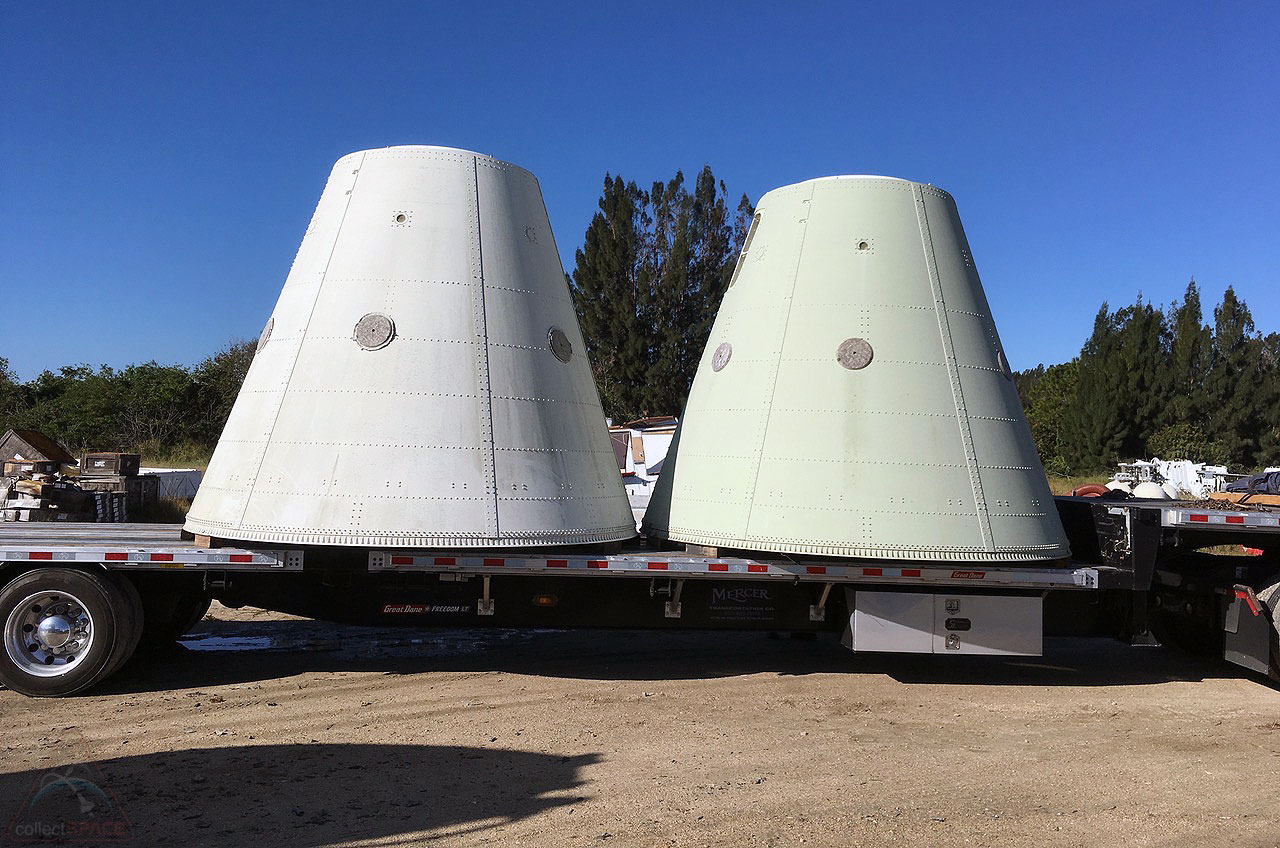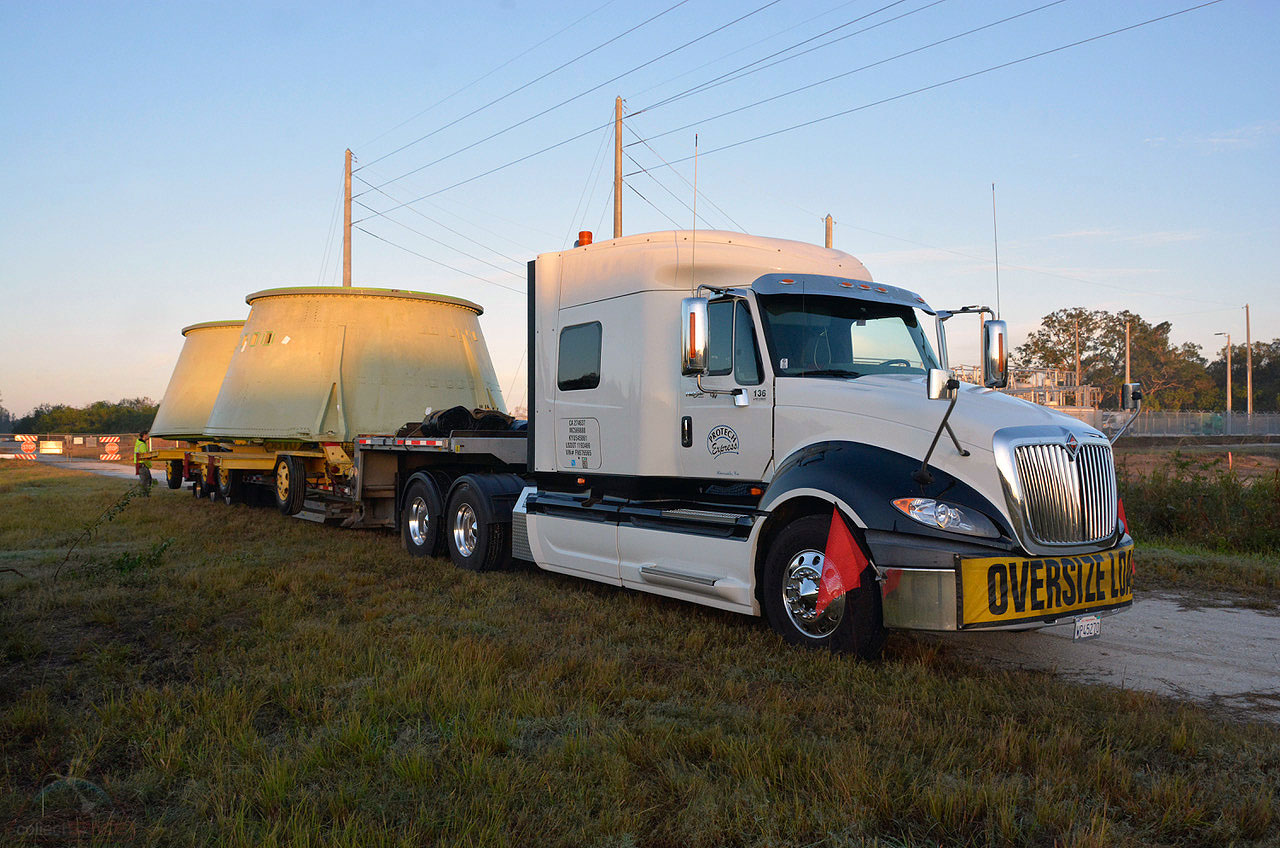Shuttling Space Artifacts: Rocket Booster Parts Bound for Endeavour Exhibit

The pieces are coming together for the towering, launch-pad-like display of NASA's retired space shuttle Endeavour.
Three large parts from two solid rocket boosters are now on a cross country road trip in preparation for the planned 2019 exhibit at the California Science Center in Los Angeles.
The components, two 7.5-foot-tall (2.3 meter) aft skirts that each sat at the base of a booster, and a 10-foot-tall (3 m) frustum that sat below the nose cap at the top, were loaded onto trucks at NASA's Kennedy Space Center in Florida last Tuesday (Dec. 6) and are slated to arrive at the space agency's Armstrong Flight Research Center in southern California later this week, on (or about) Thursday (Dec. 15). [Photos: Space Shuttle Endeavour at the California Science Center]
There, the skirts and frustum will join other solid rocket motor segments delivered in August 2012. They will be held in storage until they are needed to assemble the vertical stack for the space shuttle Endeavour at the California Science Center's new Samuel Oschin Air and Space Center in Los Angeles' Exposition Park.
"The aft skirts, in particular, are a challenging move because they are 18 feet wide [5.5 m] and require escorts all the way across the country," said Dennis Jenkins, the project director for the Endeavour exhibit.
When fully assembled, each solid rocket booster will stand 149 feet tall (45.5 m). When they were loaded with fuel, a pair of boosters comprised over half the mass of the shuttle stack at liftoff and provided the majority of the thrust for the first two minutes of flight.
After expending their fuel supply, the solid rockets were jettisoned from the orbiter and parachuted to an ocean splashdown, where they were recovered for reuse.
Get the Space.com Newsletter
Breaking space news, the latest updates on rocket launches, skywatching events and more!

The two aft skirts bound for California flew on a combined 15 space shuttle flights, dating back to the third mission, STS-3, in 1982. One of the skirts, serial number 00009, lifted off 11 times, last flying with Endeavour in 2010 (STS-130). The other aft skirt, serial no. 20022, launched four times, including on the return to flight after the loss of Columbia (STS-114 in 2005) and finally on STS-128 in 2009. [NASA's Space Shuttle Endeavour: 6 Surprising Facts]
The frustum for Endeavour's display, serial no. 20023, flew on 12 missions. Its first flight, STS-27, was in 1988. It last launched in 2010 on the penultimate flight of the space shuttle Atlantis.
When completed, the Science Center will display the only fully-authentic, vertical display of a space shuttle launch vehicle. The educational institution and museum was awarded the Endeavour in April 2012, one year after the retirement of NASA's fleet, and has exhibited it horizontally inside its Samuel Oschin Display Pavilion for the past four years.
In May, the Science Center took delivery of NASA's last flight-worthy space shuttle external tank after a five-week, 5,000-mile (8,000-km) ocean voyage that sailed it by barge from NASA's Michoud Assembly Facility in New Orleans to Los Angeles via the Panama Canal.
The twin solid rocket boosters are the last major component of the shuttle stack needed to complete the vertical Endeavour display.
"We appreciate NASA's continued support in providing the surplus flight hardware we require for this exciting and unique new exhibit," said Jeff Rudolph, president of the California Science Center.
The convoy delivering the solid rocket parts to NASA's Armstrong Flight Research Center is also transporting an additional frustum for the March Field Air Museum in Riverside, California.
See more photos of the rocket booster parts now bound for California at collectSPACE.
Follow collectSPACE.com on Facebook and on Twitter at @collectSPACE. Copyright 2016 collectSPACE.com. All rights reserved.
Join our Space Forums to keep talking space on the latest missions, night sky and more! And if you have a news tip, correction or comment, let us know at: community@space.com.

Robert Pearlman is a space historian, journalist and the founder and editor of collectSPACE.com, a daily news publication and community devoted to space history with a particular focus on how and where space exploration intersects with pop culture. Pearlman is also a contributing writer for Space.com and co-author of "Space Stations: The Art, Science, and Reality of Working in Space” published by Smithsonian Books in 2018.In 2009, he was inducted into the U.S. Space Camp Hall of Fame in Huntsville, Alabama. In 2021, he was honored by the American Astronautical Society with the Ordway Award for Sustained Excellence in Spaceflight History. In 2023, the National Space Club Florida Committee recognized Pearlman with the Kolcum News and Communications Award for excellence in telling the space story along the Space Coast and throughout the world.











